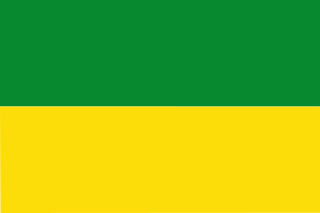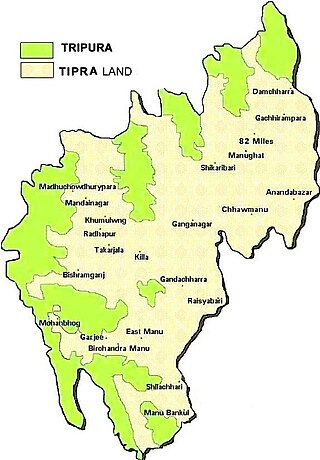Related Research Articles

Tripura is a state in northeastern India. The third-smallest state in the country, it covers 10,491 km2 (4,051 sq mi); and the seventh-least populous state with a population of 3.67 million. It is bordered by Assam and Mizoram to the east and by Bangladesh to the north, south and west. Tripura is divided into 8 districts and 23 sub-divisions, where Agartala is the capital and the largest city in the state. Tripura has 19 different tribal communities with a majority Bengali population. Bengali, English and Kokborok are the state's official languages.

The Indigenous Nationalist Party of Twipra was a political party in the Indian state of Tripura. Bijoy Kumar Hrangkhawl was the president of the party. It merged with the Tipraha Indigenous Progressive Alliance (TIPRA) party on 11 June 2021.

Kokborok (or Tripuri) is a Tibeto-Burman language of the Indian state of Tripura and neighbouring areas of Bangladesh. Its name comes from kók meaning "verbal" or "language" and borok meaning "people" or "human", It is one of the ancient languages of Northeast India.

The Tripura Tribal Areas Autonomous District Council(TTAADC) is an autonomous district council administering the Tiprasa-dominated areas of the state of Tripura, India. Its council and assembly are situated in Khumulwng, a town 26 km away from Agartala, the state capital.
Khumulwng is a town in the West Tripura district in the Indian state of Tripura. It is the headquarters and the largest town of the Tripura Tribal Areas Autonomous District Council.
Tripura National Volunteers was a Tripuri nationalist militant group in the Tripura region of India that launched an armed struggle in the early 1980s to separate Tripura from India. TNV was led by Bijoy Kumar Hrangkhawl.

The State of Tripura, in northeastern India, has a long history. The Twipra Kingdom at its peak included the whole eastern region of Bengal from the Brahmaputra River in the north and west, the Bay of Bengal in the south and Burma to the east during the 14th and 15th centuries AD.

The Tripuri people (Kókborok: Tripuri dópha rok, are a Tibeto-Burman-speaking ethnic group of Bangladesh and Northeast Indian state of Tripura. They are the descendants of the inhabitants of the Twipra/Tripura Kingdom in North-East India and Bangladesh. The Tripuri people through the Manikya dynasty ruled the Kingdom of Tripura for over 600 years starting from 1400 A.D. until the kingdom joined the Indian Union on 15 October 1949. The Tipra Dynasty was established in 590 AD.
Rajmala is a chronicle of the Kings of Tripura, written in Bengali verse in the 15th century under Dharma Manikya I.
The issue of which script to use for the Kokborok language continues to provoke political controversy.
Reang is one of the Tripuri clan of the Northeast Indian state. The Reangs can be found all over the Tripura state in India. However, they may also be found in Assam and Mizoram. They speak the Reang dialect similar to Kokborok language, which has Tibeto-Burmese roots and is locally known as Kau Bru.
Tripuri refer to:
The Twipra Kingdom was one of the largest historical kingdoms of the Tripuri people in Northeast India.

The Indigenous Peoples Front of Tripura (IPFT) is a regional political party in Tripura, India. It is a member of the National Democratic Alliance and North-East Democratic Alliance. The party was merged into the Indigenous Nationalist Party of Tripura (INPT) in 2001, However diverged out in 2009. The party is allied with BJP in the 2018 Tripura Legislative Assembly election and won eight seats out of eight contested seats. The party got 7.5% of the total votes polled. The BJP got 36 seats and with a total of 44 seats the BJP-IPFT coalition have two-thirds majority at the Legislative Assembly.

Tipraland is the name of a proposed state in India for the indigenous Tripuri people in the tribal areas of the Tripura state. They demand the Tripura Tribal Areas Autonomous District Council and some surrounding areas to be made into a separate state from Tripura. The proposed state covers 68% of the total geographical area of the Tripura and is home to over one-third of the total population of Tripura.

The Tripura Buranji is an account of the diplomatic contacts between the Ahom kingdom and the Tripura Kingdom between 1709 and 1715. The Buranji was written in 1724 by the envoys of the Ahom kingdom, Ratna Kandali Sarma Kataki and Arjun Das Bairagi Kataki. It describes three diplomatic missions that was sent to the Twipra kingdom, two return missions accompanied by Tripuri envoys, incidental descriptions of palaces, ceremonies and customs; and it also provides an eye witness account of the Twipra king Ratna Manikya II (1684–1712) deposed by his step-brother Ghanashyam Barthakur, later Mahendra Manikya (1712–1714).

The following outline is provided as an overview of and topical guide to Tripura:

Tipraland State Party (TSP) is a regional political party in Tripura, India.

Rabindra Debbarma is an Indian Tiprasa politician from Tripura who is an Executive Member of the Tripura Tribal Areas Autonomous District Council (TTAADA) from Simna-Tamakari constituency. He is also the Chief Whip of TIPRA Motha Party in TTAADC.
References
- D. C. Sircar, Some Epigraphical Records of the Mediaeval Period From Eastern India, Abhinav Publications, 1979, 93f.